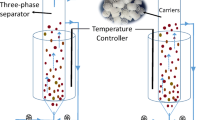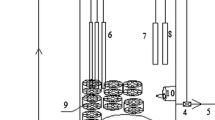Abstract
Anammox process has attracted considerable attention in the recent years as an alternative to conventional nitrogen removal technologies. In this study, a column type reactor using a novel net type acrylic fiber (Biofix) support material was used for anammox treatment. The Biofix reactor was operated at a temperature of 25°C (peak summer temperature, 31.5°C). During more than 340 days of operation for synthetic wastewater treatment, the nitrogen loading rates of the reactor were increased to 3.6 kg-N/m3/d with TN removal efficiencies reaching 81.3%. When the reactor was used for raw anaerobic sludge digester liquor treatment, an average TN removal efficiency of 72% was obtained with highest removal efficiency of 81.6% at a nitrogen loading rate of 2.2 kg-N/m3/d. Results of extracellular polymeric substances (EPS) quantification revealed that protein was the most abundant component in the granular sludge and was found to be almost twice than that in the sludge attached to the biomass carriers. The anammox granules in the Biofix reactor illustrated a dense morphology substantiated by scanning electron microscopy and EPS results. The results of DNA analyses indicated that the anammox strain KSU-1 might prefer relatively low nutrient levels, while the anammox strain KU2 strain might be better suited at high nutrient concentration. Other types of bacteria were also identified with the potential of consuming dissolved oxygen in the influent and facilitating survival of anammox bacteria under aerobic conditions.







Similar content being viewed by others
References
APHA, AWWA, WEF (1995) Standard methods for the examination of water and wastewater, 19th edn. American Public Health Association, Washington DC, USA
Dubois M, Gilles KA, Hamilton JK, Rebers PA, Smith F (1956) Colorimetric method for determination of sugars and related substances. Anal Chem 28(3):350–356. doi:10.1021/ac60111a017
Experimental Guidelines for Biotechnology (1992) Society of Fermentation and Bioengineering, Osaka, Japan, pp 98–99 (in Japanese)
Fujii T, Sugino H, Rouse JD, Furukawa K (2002) Characterization of the microbial community in an anaerobic ammonium-oxidizing biofilm cultured on a nonwoven biomass carrier. J Biosci Bioeng 94:412–418
Furukawa K, Rouse JD, Imajo U, Nakamura K, Ishida H (2001) Anaerobic oxidation of ammonium confirmed in continuous flow treatment using a non-woven biomass carrier. Jpn J Water Treat Biol 38(2):87–94
Furukawa K, Rouse JD, Yoshida N, Hatanaka H (2003) Mass cultivation of anaerobic ammonium-oxidizing sludge using a novel nonwoven biomass carrier. J Chem Eng of Jpn 36(10):1163–1169. doi:10.1252/jcej.36.1163
Kanda J (1995) Determination of ammonium in seawater based on the indophenol reaction with o-phenylphenol (OPP). Water Res 29:2746–2750. doi:10.1016/0043-1354(95)00149-F
Laspidou CS, Rittmann BE (2002) A unified theory for extracellular polymetic substances, soluble microbial products, and active and inert biomass. Water Res 36:2711–2720. doi:10.1016/S0043-1354(01)00413-4
Lowry OH, Rosebrough NJ, Farr AL, Randall RJ (1951) Protein measurement with the folin phenol reagent. J Biol Chem 193:265–275
Mulder A, van de Graaf AA, Robertson LA, Kuenen JG (1995) Anaerobic ammonium oxidation discovered in a denitrifying fluidized bed reactor. FEMS Microbiol Ecol 16:177–184. doi:10.1111/j.1574-6941.1995.tb00281.x
Muyzer G, Smalla K (1998) Application of denaturing gradient gel electrophoresis (DGGE) and temperature gradient gel electrophoresis (TGGE) in microbial ecology. Antonie Van Leeuwenhoek 73:127–141. doi:10.1023/A:1000669317571
Pathak BK, Kazama F, Saiki Y, Sumino T (2007) Presence and activity of anammox and denitrification process in low ammonium-fed bioreactors. Bioresour Technol 98:2201–2206. doi:10.1016/j.biortech.2006.08.014
Schmid I, Schmid M, Cirpus I, Strous M, Bock E, Kuenen JG et al (2002) Aerobic and anaerobic ammonia oxidizing bacteria-competitors or natural partners? FEMS Microbiol Ecol 39:175–181
Sekiguchi Y, Takahashi H, Kamagata Y, Ohashi A, Harada H (2001) In situ detection, isolation, and physiological properties of a thin filamentous microorganism abundant in methanogenic granular sludge: a novel isolate affiliated with a clone cluster, the green non-sulfur bacteria, subdivision I. Appl Environ Microbiol 67(12):5740–5749. doi:10.1128/AEM.67.12.5740-5749.2001
Sliekers AO, Third k, Abma W, Kuenen JG, Jetten MSM (2003) Canon and anammox in a gas-lift reactor. FEMS Microbiol Lett 218:339–344. doi:10.1016/S0378-1097(02)01177-1
Strous M, van Gerven E, Kuenen JG, Jetten M (1997) Ammonium removal from concentrated wate steams with the anaerobic ammonium oxidation (Anammox) process in different reactor configurations. Water Res 31:1955–1962. doi:10.1016/S0043-1354(97)00055-9
Strous M, Fuerst JA, Kramer EHM, Logemann S, Muyzer G, van de Passchoonen KT et al (1999a) Missing lithotroph identified as new planctomycete. Nature 400:446–449. doi:10.1038/22749
Strous M, Kuenen JG, Jetten MSM (1999b) Key physiological parameters of anaerobic ammonium oxidation. Appl Microbiol Biotechnol 65:3248–3250
Van de Graaf AA, de Bruijn P, Robertson LA, Jetten MSM, Kuenen JG (1996) Autotrophic growth of anaerobic ammonium-oxidezing microofganisms in a fluidized bed reactor. Appl Environ Microbiol 142:2187–2196
Wingender J, Neu TR, Flemming H-C (1999) What are bacterial extracellular polymeric substances? In: Wingender J, Neu TR, Flemming H-C (eds) Microbial extracellular polymeric substances: characterization, structure and function. Springer, Berlin
Yamada T, Sekiguchi Y, Imachi H, Kamagata Y, Ohashi A, Harada H (2005) Diversity, localizaiont, and physiological properties of filamentous microbes belonging to Chloroflexi subphylum I in mesophilic and thermophilic methanogenic sludge granules. Appl Environ Microbiol 71(11):7493–7503. doi:10.1128/AEM.71.11.7493-7503.2005
Author information
Authors and Affiliations
Corresponding author
Rights and permissions
About this article
Cite this article
Qiao, S., Kawakubo, Y., Cheng, Y. et al. Identification of bacteria coexisting with anammox bacteria in an upflow column type reactor. Biodegradation 20, 117–124 (2009). https://doi.org/10.1007/s10532-008-9205-3
Received:
Accepted:
Published:
Issue Date:
DOI: https://doi.org/10.1007/s10532-008-9205-3




